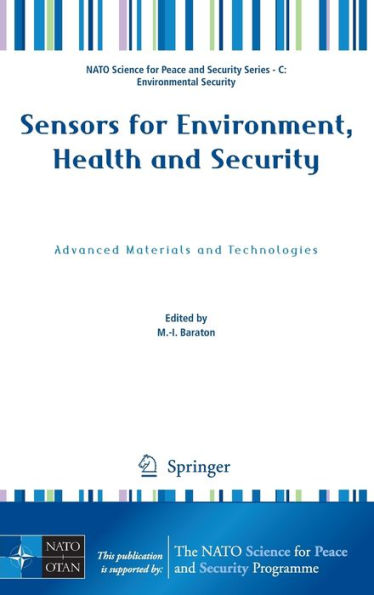Sensors for Environment, Health and Security: Advanced Materials and Technologies
The NATO Advanced Study Institute on “Sensors for Environment, Health and Security: Advanced Materials and Technology” was held in Vichy (France) on September 16–27, 2007 where more than 65 participants, ranging from Ph. D. students to experienced senior scientists, met and exchanged ideas and know-how in a friendly atmosphere. The present book intends to cover the main topics of this NATO ASI through 32 chapters distributed over two parts (Part I: “Materials and Technologies” and Part II: “Applications to Environment, Health and Security”). The scientific programme of the NATO ASI consisted in 28 1-hour lectures given by 14 invited lecturers, 5 additional 1-hour lectures given by seminar speakers, 22 oral presentations by selected ASI participants and a poster session. The programme was divided into four sessions: (1) Advanced materials and technologies; (2) Sensors for environment; (3) Sensors for health; (4) Sensors for security. During the “Advanced Materials and Technologies” session (Part I of the present book), the lectures were dedicated to critical analyses of current methods for the synthesis of materials, nanomaterials (nanoparticles, nanowires, nanotubes, …) and nanocomposites to be used for the fabrication of sensing devices, mainly semiconductor sensors. Among the synthesis methods, chemical (sol-gel, etc. ) and physical methods (laser deposition, DC magnetron sputtering, etc. ) were discussed. Several lectures addressed characterization techniques and it was concluded that the physical and chemical control of the materials/nanomaterials, including surface chemistry, remains a key issue for the reproducibility of the final device.
1111366344
Sensors for Environment, Health and Security: Advanced Materials and Technologies
The NATO Advanced Study Institute on “Sensors for Environment, Health and Security: Advanced Materials and Technology” was held in Vichy (France) on September 16–27, 2007 where more than 65 participants, ranging from Ph. D. students to experienced senior scientists, met and exchanged ideas and know-how in a friendly atmosphere. The present book intends to cover the main topics of this NATO ASI through 32 chapters distributed over two parts (Part I: “Materials and Technologies” and Part II: “Applications to Environment, Health and Security”). The scientific programme of the NATO ASI consisted in 28 1-hour lectures given by 14 invited lecturers, 5 additional 1-hour lectures given by seminar speakers, 22 oral presentations by selected ASI participants and a poster session. The programme was divided into four sessions: (1) Advanced materials and technologies; (2) Sensors for environment; (3) Sensors for health; (4) Sensors for security. During the “Advanced Materials and Technologies” session (Part I of the present book), the lectures were dedicated to critical analyses of current methods for the synthesis of materials, nanomaterials (nanoparticles, nanowires, nanotubes, …) and nanocomposites to be used for the fabrication of sensing devices, mainly semiconductor sensors. Among the synthesis methods, chemical (sol-gel, etc. ) and physical methods (laser deposition, DC magnetron sputtering, etc. ) were discussed. Several lectures addressed characterization techniques and it was concluded that the physical and chemical control of the materials/nanomaterials, including surface chemistry, remains a key issue for the reproducibility of the final device.
219.99
In Stock
5
1

Sensors for Environment, Health and Security: Advanced Materials and Technologies
497
Sensors for Environment, Health and Security: Advanced Materials and Technologies
497Hardcover(2009)
$219.99
219.99
In Stock

Product Details
| ISBN-13: | 9781402090080 |
|---|---|
| Publisher: | Springer Netherlands |
| Publication date: | 11/21/2008 |
| Series: | NATO Science for Peace and Security Series C: Environmental Security |
| Edition description: | 2009 |
| Pages: | 497 |
| Product dimensions: | 6.40(w) x 9.30(h) x 1.40(d) |
From the B&N Reads Blog
